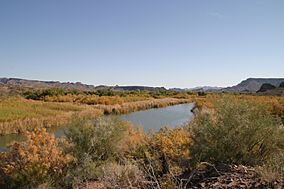Bill Williams River National Wildlife Refuge facts for kids
Quick facts for kids Bill Williams River National Wildlife Refuge |
|
|---|---|
|
IUCN Category IV (Habitat/Species Management Area)
|
|
 |
|
| Location | La Paz / Mohave counties, Arizona, United States |
| Nearest city | Parker, AZ / Lake Havasu City, AZ |
| Area | 6,105 acres (24.71 km2) |
| Established | 1941, 1993 (as Bill Williams) |
| Governing body | U.S. Fish and Wildlife Service |
| Website | Bill Williams River National Wildlife Refuge |
The Bill Williams River National Wildlife Refuge is a special place in western Arizona. It protects the lower part of the Bill Williams River as it flows into Lake Havasu. This important area is found in La Paz and Mohave Counties.
The United States Fish and Wildlife Service manages this federal wildlife refuge. Visitors can enjoy many fun activities here. You can take nature walks, go bird watching, hike, or even go kayaking on the Bill Williams River. It's a great spot to explore nature!
Contents
Discovering the Refuge's Nature
The Bill Williams River National Wildlife Refuge is home to a unique mix of natural areas. It has parts of the Mojave Desert and Sonoran Desert. It also features special river areas called riparian zones and wet marshlands. This variety of habitats helps many different plants and animals live here.
Plants of the Desert & River
The refuge sits in a special "transition zone" between the Mojave Desert and Sonoran Desert. This means it has plants from both desert types, making it very diverse. You can see tall saguaro cacti, wetland plants like broadleaf cattail, and cottonwood trees all in one view.
The refuge protects the largest remaining group of cottonwood-willow forests along the lower Colorado River. The main trees you'll find are Fremont's cottonwood and Goodding's willow. These forests are very important for the wildlife.
Amazing Animals of the Refuge
The rare river habitat of the Bill Williams River Refuge supports many animals that live there all the time. It also attracts many migratory birds. These birds travel from Central and South America to their breeding grounds in the north.
The refuge is a safe home for some endangered bird species. The southwestern willow flycatcher builds its nests here. The Yuma rail lives in the marsh's broadleaf cattail areas. This bird is special because it only lives in the Lower Colorado River Valley.
Here are some of the animals you might find at the refuge:
- Birds: southwestern willow flycatcher, vermillion flycatcher, yellow-billed cuckoo, western tanager, lazuli bunting, Yuma rail
- Mammals: North American beaver, bobcat, cougar, gray fox, collared peccary, mule deer, desert bighorn sheep, ring-tailed cat
- Amphibians: Colorado River toad
- Fish: razorback sucker and bonytail chub
Helping the Refuge: Friends of the Refuge
The Friends of the Bill Williams River and Havasu National Wildlife Refuges is a special group. It's a non-profit organization, which means they don't make money for themselves. Instead, they support the Bill Williams River National Wildlife Refuge and the Havasu National Wildlife Refuge.
These "Friends" work hard to help the refuges. They try to get grants to support projects and raise money for education programs. They also help the Fish and Wildlife Service by volunteering their time. They assist with events and help keep the refuge facilities running smoothly.



